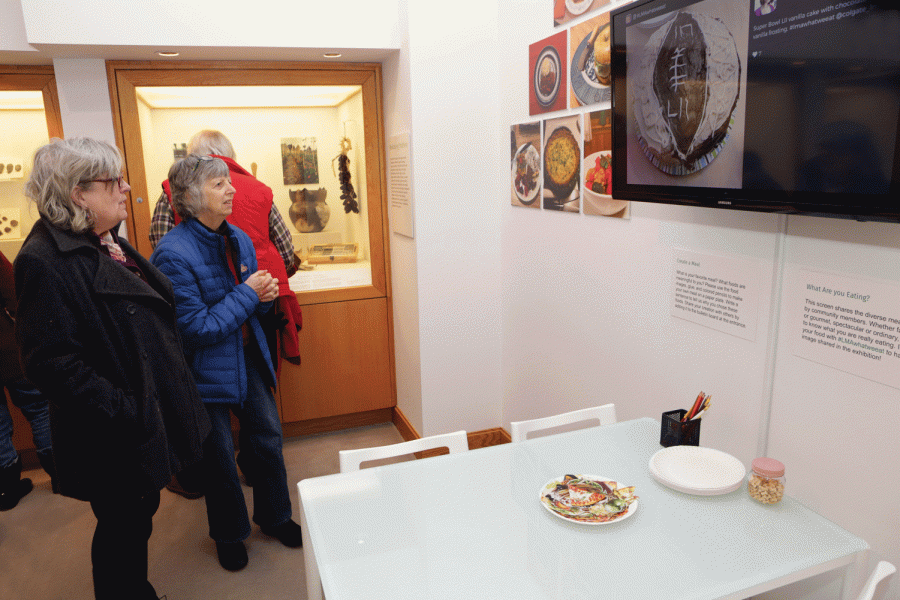“Setting the Table” Exhibit Proves Appetizing
The Longyear Museum of Anthropology officially opened the exhibit titled “Setting the Table: Food, Place, Community” on Thursday, February 8 at 4:30 p.m. The turnout was impressive, with students, professors, and members of the Hamilton community showing up to appreciate art and discuss the universally shared impact of food on community. In the spirit of appreciating food, refreshments were served at the exhibit’s opening, including cupcakes from Flour and Salt.
The exhibit draws inspiration from Colgate University faculty and students, including students enrolled in the Fall 2017 course entitled “Food” with Associate Professor of Sociology Christopher Henke.
In addition, Professor of Sociology and Anthropology and Native American Studies Jordan Kerber, worked with curators regarding food-related objects representing Native communities in the Longyear Museum’s archaeology collection.
The exhibit investigates why food is so essential on both an individual and a community-based level. As stated on the opening sign in the exhibit, “We eat for sustenance and for health, for identity and for tradition, for family and for love, for comfort and for strength. We eat to remember, to survive, to revitalize, to sustain, to nurture, and to commune.”
Crucial topics are addressed through art, including food systems, foodways, business, identity, health and well-being and cultural traditions. In addition to shaping identities and communities, food is also a means through which social and political change is activated.
Student curators organized, researched and executed sections of the exhibit. One particularly impactful aspect featured stories from international students about their favorite food dishes and their significance, including countries such as India and South Korea.
“We wanted to have a section on international voices, and the best way to do that was with international students at Colgate. We did a lot of research about how food and memory are tied together. We had students send us stories about identity, memory and their childhood, plus pictures,” student curator sophomore Olivia Miller said.
Sophomore Rupika Chakraverti, from Kolkata, India, shared one of the stories featured in this section of the exhibit; she spoke about the intersections between food, politics, rights and freedom, all connected through something as simple as beef rolls.
“When I think of food from home, I am filled not only with nostalgia, but also with a sense of pride… As Kolkata becomes one of the increasingly rare places left in India to freely eat beef without a fear of judgment, I grow more and more thankful to grow up in a city which at least tries to protect the freedom of its residents,” Chakraverti said.
Another section of the exhibit focused on local businesses in Central New York, including Flour and Salt, G&M Farms, Good Nature Brewery, Old Home Distillers, Chobani, Kriemhild Dairy Farms and the Common Thread Community Farm. This section raised questions about how to define “local food,” facilitating a sense of community through food, and the importance of sustaining small-scale economies.
The local business section was also coupled with history, including the fact that in 1930, there were 3,208 farms in Madison County, while today that number has drastically declined to 838.
Christy DeLair, PhD, the Associate Curator for the Longyear Museum of Anthropology, made the opening statements for the exhibit.
“[Food] presents challenges because [it] isn’t exactly a material we put into museums. We don’t have all of the objects in the museum that would allow us to tell some of these stories about local food, so we had to work with a lot of community members,” DeLair said.
Because Central New York has such a rich history of Native American communities in the area, the exhibit included a section about the impact of their food traditions. This raised attention to the issue of colonization and violence forcing Native Americans to relocate and become disconnected with their food traditions and beliefs.
“Each section of the exhibit touches on something different because there are so many facets to food and what it means to people. During my time at Colgate, I’ve watched Flour and Salt grow, so it was important to have a section in the exhibit about local businesses like that. We have all of these materials in the museum in addition to Native people, such as the Haudenosaunee, all around us,” student curator and junior Sierra Sunshine said.
The exhibit will continue to run through June 3, 2018.
Contact Allegra Padula at [email protected].







